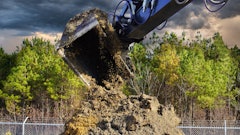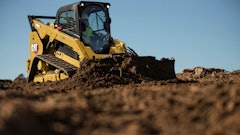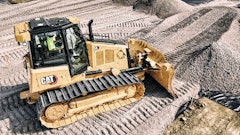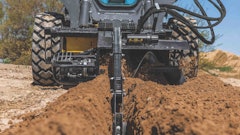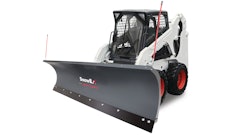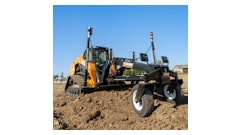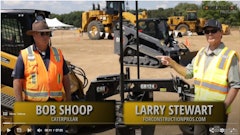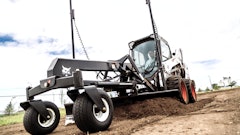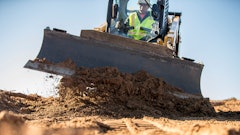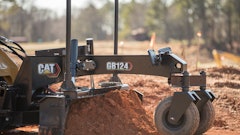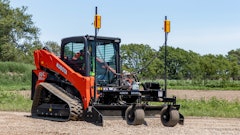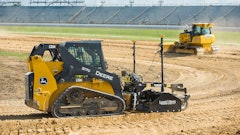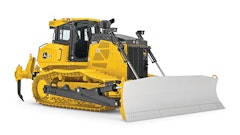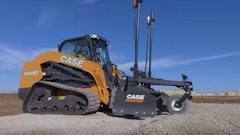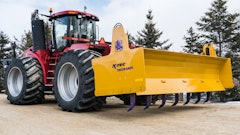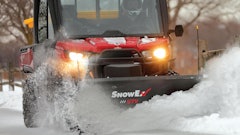
One attachment that lends itself to the versatility every contractor can use is the dozer blade. It takes on heavy-duty work day in and day out, preparing worksites, grading roads, creating ditches and pushing tons of snow.
Dozer blades are built to be multipurpose, but not all are created equal. Selecting one should go beyond sheer compatibility with a tractor. In fact, careful consideration of the blade’s design and capabilities can have a huge impact on how versatile it really is, how quickly and efficiently it can complete projects and how long it’s going to last.
Results May Vary
While the general design of a blade is simple, there are several components that vary from manufacturer to manufacturer and they can impact what you can do, how much you can do and where you can do it.
Capacity is one of the key factors to consider, and it is determined by the height and width of the blade. Heights range from 27 to 48 in., and most manufacturers offer extensions that bring their blades up to 72 in. The taller height allows operators to push more material, which results in fewer passes, and reduces the chance of material flowing up and over the top the blade. For even greater capacity, manufacturers offer optional box end plates that can be mounted to each end of the blade. This helps keep more material contained so operators can push more in fewer trips.
Blade widths range from 8 to 20 ft. Some can be adjusted from 12 to 20 ft. on the fly to give operators the capacity of a larger blade and the flexibility to access hard-to-reach areas. The operator can retract the blade to get close to buildings, then extend it to maximize the amount of material transferred.
How much material a blade can push is one thing, but its flexibility to tilt and angle can dramatically affect how much control the operator actually has. Most dozer blades are either four- or six-way styles. A four-way blade moves up and down and angles left and right, which is ideal for pushing snow and dirt to one side. It also reduces the amount of material that flows over the sides, so each pass is cleaner and there is less need for backtracking. In some cases, angling the blade left or right also can provide enough clearance to maneuver around busy jobsite between equipment or through gates. A six-way blade also moves up and down and angles left and right, but unlike the four-way, each side also tilts up or down. In other words, an operator can raise either side of the blade higher than the other. This is especially helpful for working through tough soil when grading and leveling roads and construction sites.
Depending on the model, operators can adjust the blade angle manually or hydraulically. A manually adjustable blade requires the operator to jump down from the machine and move the blade to the desired angle by hand. This not only takes time, but also increases the risk of injury during the winter when the chance of slipping or falling on the snow and ice is greater. A blade that has a hydraulically powered angling system is safer, faster and easier because it can be adjusted from inside the cab.
Most dozer blades move up and down, but how far they reach can impact capabilities. Lift heights vary from 23 to 48 in. Blades with lower lift heights are limited to low-level applications, such as landscaping and grading roads, and can only stack material in small piles. Higher lift heights allow users to stack more material like soil or snow into steeper piles, which helps saves space. Operators also can lift the blade high enough to avoid back dragging that would otherwise remove material they just added to the pile and require rework.
Do It Right the First Time
A blade that can adjust to application requirements gives users flexibility to tackle a wide range of projects, but even better is a blade that saves time while doing those jobs.
While the ideal blade height depends on the application, maintaining optimal control of material, whether it’s 4 in. or 4 ft. in the air, is important for every application. A parallel lift system, which is available on some blades, allows the operator to maintain precise control because it keeps the blade straight up and down as it’s lifted.
This type of system also helps maintain a more even weight distribution between the front and rear axles because it keeps the blade closer to the front of the carrier. Ideally, a carrier will always have 50% of the weight over the front axle and 50% over the rear so the front and rear tires are doing the same amount of work. This not only makes the carrier more efficient, but also adds life to the drivetrain.
Weight transfer can also be an issue with standard lift systems. Blades that are mounted on a hinge tend to tilt backward as they’re raised, transferring weight and reducing operator control.
Finally, a blade that’s mounted close to the carrier gives operators more control while driving over rough terrain. The further the blade is from the machine, the more it will bounce up and down, requiring constant adjustment from the operator to maintain the desired height.
Material vs. Blade
All these features and benefits are great, but it means nothing if the blade isn’t designed with durability in mind. If a blade can’t stand up to the wear and tear of grading, ditching and pushing large amounts of heavy materials, you might be looking for a new one sooner than you think.
To avoid this, look for a blade made with heavy-duty steel that will stand up to repetitive use and last longer. Joints also should be reinforced with gussets that help strengthen the system.
To avoid damage to hydraulic hoses when maneuvering over rough terrain or materials, look for a system that routes them up and out of the way. This also prevents buildup of material and saves operators the time and hassle of having to clean it out. Some systems even incorporate steel routing instead of rubber for greater durability.
Maintaining a dozer blade is simple. It usually only requires greasing of zerks and replacing cutting edges. However, there are a few things that further simplify maintenance. Some manufacturers design blades with zerks that are easy to access, which saves time and hassle when greasing. Also, some blades feature reversible cutting edges; when one side becomes worn, it can be flipped over and used again.



